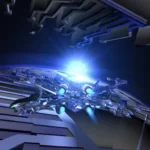Discovery of a New Ultra-Diffuse Galaxy in the Leo Constellation
A team of Indian astronomers has identified an ultra-diffuse galaxy (UDG) forming at the end of a massive tidal tail in the Leo constellation. This significant discovery was led by a collaborative team of scientists from the Indian Institute of Astrophysics (IIA) Bengaluru, Pondicherry University, the SKA Observatory in the United Kingdom and the National Center for Radio Astronomy (NCRA) in Pune and published in the journal Astronomy & Astrophysics.
Ultra-diffuse galaxies are known for their large size but very faint brightness and the formation of this new galaxy is the result of gravitational interaction between NGC 3785 and a neighbouring galaxy. They contain only a fraction of the stars found in typical galaxies like the Milky Way. This newly discovered UDG is located at the end of a tidal tail stretching from NGC 3785, a galaxy approximately 430 million light-years away.
“We found that this extraordinary tidal tail stretches for 1.27 million light-years, making this the longest tidal tail discovered so far,” explains Chandan Watts, a Ph.D student at IIA and the study’s lead author.
The tidal tail composed of gas, stars, and debris pulled out during galactic interactions measures an impressive 1.27 million light-years, making it the longest such structure ever observed. Researchers suggest that the UDG forming at its tip is the result of gravitational forces shaping material within the tail.
This finding sheds light on the complex processes involved in galaxy formation, emphasizing the role of tidal interactions in creating new galactic structures. It also highlights the importance of studying faint, low-density galaxies to better understand the universe’s diversity.







